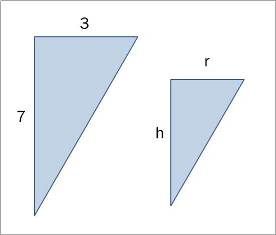An inverted right circular cone is filled with liquid. The cone has a radius of 3m and height of 7m. The liquid flows from the apex of the cone at a constant rate of 0.6m3/min. Find the rate at which the depth of the liquid is dropping, when the depth of the liquid is 2m.
"The liquid flows from the apex of the cone at a constant rate of 0.6m
3/min."

(note the negative because it is flowing out!)
"Find the rate at which the depth of the liquid is dropping, when the depth of the liquid is 2m."

Set up your chain rule equation:

Now we need to find what dh/dV is. Let's first find dV/dh, then we can flip it to get dh/dV. We know that it is a right circular cone so it follows that:

- but we cannot differentiate this straight away in terms of 'h' because there is another variable 'r' in the equation, so we need to eliminate the 'r'. So this is where similar triangles comes in:


We have found what 'r' is in terms of h, so let's sub this back into V:
^2h=\frac{3}{49}\pi h^3)
Now let's differentiate it with respect to 'h' and flip it:

Bring this back into the chain rule equation and substitute in our given condition where h=2:


The depth of the liquid is
decreasing at a rate of
)
when the depth of the liquid is 2m.

